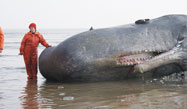
Rye’s Reidenberg Stars in a Whale of a Series
When you’re in the “whale business”, receiving a phone call near the end of the workday requesting you hop on a transatlantic flight scheduled to depart at 6 p.m. is simply part of the job.
By Jim Byrne
When you’re in the “whale business”, receiving a phone call near the end of the workday requesting you hop on a transatlantic flight scheduled to depart at 6 p.m. is simply part of the job.
 That call was the impetus for Dr. Joy Reidenberg’s starring role in the British program “Inside Nature’s Giants”, now in its fourth season. Beginning January 18 on PBS, the series will make its U.S. debut as part of the channel’s Science and Natural History Lineup. Dr. Reidenberg, a comparative anatomist and professor at Mount Sinai School of Medicine, is a Rye resident and president of the Friends of Read Wildlife Sanctuary.
That call was the impetus for Dr. Joy Reidenberg’s starring role in the British program “Inside Nature’s Giants”, now in its fourth season. Beginning January 18 on PBS, the series will make its U.S. debut as part of the channel’s Science and Natural History Lineup. Dr. Reidenberg, a comparative anatomist and professor at Mount Sinai School of Medicine, is a Rye resident and president of the Friends of Read Wildlife Sanctuary.
The series boasts that it reveals the evolutionary secrets and anatomical mysteries of some of nature’s largest animals, including the sperm whale, the python, lions, tigers, and the great white shark. Whales were not part of the original scope of the program, but when a 65-foot fin whale washed up in Ireland in early 2009, Dr. Reidenberg was contacted for her expertise in the field.
“I didn’t know what I was getting into, and they hadn’t filmed anything yet for the series, but I thought, ‘Why not?’ It sounded like a great adventure.”
Dr. Reidenberg, who is married with two daughters, planned to spend the weekend with her family, but an email from a colleague inquiring about her interest in participating in the series triggered a chain of frantic events that ended with her on a beach in Ireland. Despite rain, wintery conditions, a fast-fading sun, and no real outline, Dr. Reidenberg and the film crew performed the task at hand.
“Luckily, the whale is an animal I know so they just followed my lead,” she said. “It was kind of a sink-or-swim test for me as well – they invited me back for the rest of the series even while unsure of what my role would be.”
The film makers apparently thought she was a character perfect for television, with enthusiasm and a willingness to jump in and get messy. “Plus I was the only woman,” she added. “And my American accent didn’t hurt.”
In the episode that airs January 18 at 10 p.m., Dr. Reidenberg dissects a 45-foot sperm whale, which stranded and died on Pegwell Bay, Kent, England. One week later, she appears on screen in Florida’s Everglades, working with “python hunters” who are trying to control the invasive Burmese python population.
“It was hot and sticky, and we were wearing orange plastic boiler suits,” said Dr. Reidenberg. “But the biggest hazard was the monster alligator that kept coming out of the water to try and eat the python we were working on!”
Nothing, however, compares to the fright of what occurred while filming African safari footage for the February 8 “Big Cats” episode.
“We were watching a male lion eating a wildebeest at night, when a second male approached our truck from behind,” she recalled. “All of a sudden he roared and we all realized he was no more than 10 feet behind us. You can’t imagine what it feels like when you watch it on TV. It shook our lungs. The ranger told us not to move, and it was obvious the lion could see us even though we couldn’t see him. Someone took a pen light and pointed it in his direction, and there they were – two eyes shining back at us. I was never more scared in my life than at that moment.”
 Dr. Reidenberg says the show, which focuses on dissection but isn’t heavy on gore, is full of excitement, drama, danger, and even humor – “It’s kind of like Mission: Impossible!” Although she had dome some documentary work before, the majority of her television experience involved news broadcasts in instances where whales washed up on beaches.
Dr. Reidenberg says the show, which focuses on dissection but isn’t heavy on gore, is full of excitement, drama, danger, and even humor – “It’s kind of like Mission: Impossible!” Although she had dome some documentary work before, the majority of her television experience involved news broadcasts in instances where whales washed up on beaches.
“I’m really excited for the American debut because I feel like I’ve been sitting on the sidelines while it has aired in the U.K.,” she said. “Nobody here knows about this series, but it’s is so, so good.”
PBS plans on airing two additional episodes after the first four run. “Inside Nature’s Giants” is produced by Windfall Films, and all animals dissected in the series died naturally in the wild or in zoos, or were from officially sanctioned culls.
— Photos Courtesy Joy Reidenberg and Windfall Films















